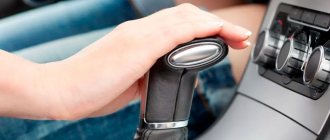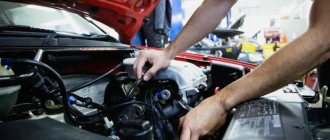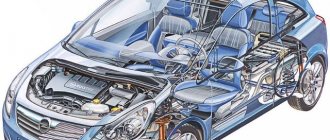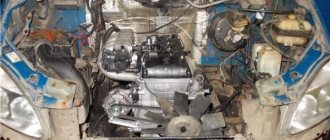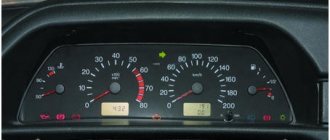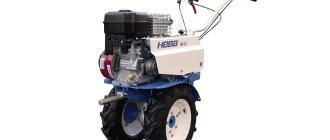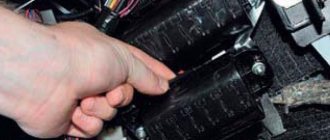The car does not gain speed above 3000–4000
A failed catalyst or a second oxygen sensor (lambda probe) are two common problems why the car does not spin the engine above 3000-4000 rpm or picks it up slowly.
We recommend throwing out the “flying” catalyst and driving calmly, turning it off using chip tuning software.
If the problem is in the oxygen sensor, then the error message on the dashboard may or may not light up. It is highly undesirable to disable the first lambda. Basically, the ECU uses it to determine how to make the mixture. Disabling the first oxygen sensor increases fuel consumption.
The second lambda performs auxiliary functions and is intended to control the quality of the catalyst. More often than not, it comes to an end. The second oxygen sensor is disabled using chip tuning - “firmware for Euro-2”. After chipping, the operating algorithm changes, and the control system does not notice the presence or absence of a sensor.
Why should you disable the second oxygen sensor?
A faulty lambda probe “sticks” in one position and displays a fixed value instead of a sine wave. The engine adjusts the mixture and does it incorrectly. There are two ways out: remove the lambda probe physically, and flash the “brains” under EURO2, or replace it with a new sensor.
We do not take into account the option with decoys - this is a half-measure that leads to improper operation of the engine. After some time, the error appears on the dashboard again.
You might think that chip tuning is a panacea for all car problems. This is wrong. It solves environmental problems (oxygen sensors, USR, particulate filter) and adds “horses” to the car. The box will not be rebuilt and the valves will not be straightened. There is no need to wait for miracles.
Diagnostics
Automatic transmission is popular today both in the domestic car market and in the foreign one. It has more than enough advantages, so it is not surprising that it is so popular. However, like any mechanism, it has the ability to break down. Most often you hear among car owners: the gearbox cannot change gears, you have to do it manually. We will talk about possible causes of failure and their diagnosis further.
First of all, before starting work, you should make sure that the problem is in the automatic transmission. That is, do all other car systems work properly if the engine cannot change gears? There are many problems that lead to a drop in the oil level in the gearbox. The main problem here is a violation of the tightness of the front automatic transmission oil seal.
Reasons for the drop in oil level in the automatic transmission:
- Oil leakage: through the crankshaft seals, through the cylinder block gasket, through the oil filter gasket, through the oil seals. The root of the first problem lies in the wear of the sealing edges of the crankshaft oil seals. This happens either due to the addition of low-quality auto chemicals or low-quality oil. The second problem may be due to overheating of the engine or due to improper tightening of the power bolts when assembling the engine. The most typical cause of the third problem is the rubber sealing ring not being retained in its cage. The fourth problem arises due to overheating of the rubber caps.
- Piston ring problems: wear, overheating, coking. Piston ring wear is a common problem because it always occurs. And, as a rule, this wear begins in areas most exposed to pressure.
- Overheating of oil scraper rings occurs at temperatures above 200. Any increase in temperature threatens failure of the piston rings. This, in turn, affects the level of oil absorption by the engine.
- Coking of piston rings occurs due to the use of low-quality oil. After all, you must admit that the rings are in good order only when they are movable. Their stagnation negatively affects engine performance.
In addition to these reasons, there are many other reasons for malfunctions of 4 and 5-speed gearboxes.
| Automatic transmission malfunction | Cause |
| After overcoming the rise, the car can switch to a lower gear ahead of time. | Low gearbox oil level, worn discs or o-rings |
| Reverse speed is fine, but the car does not move forward, but skids in place. | Wear of forward clutch discs, clogged gear shift valve, damage to oil rings |
| Shifting forward is normal, moving backward does not occur. | Problems in the operation of the brake band (it is either worn out, torn, or its piston rod is broken), malfunctions of the braking package |
| When the lever is set to neutral, the car moves forward or backward. | The drive cable or lever is not adjusted correctly, the clutch discs or plates are touching |
| The car moves when the gear shift lever is in the “N” position. | Damage to the adjustment of the cable or lever of the automatic transmission control drive, interruptions in the operation of the clutch piston, welding of friction discs to steel |
| Aluminum grains at the bottom of the pan | Wear of either the working layer of the sliding bearing, or the aluminum washer, housing, etc. |
Of course, these are not all the reasons for breakdowns of the automatic transmission itself, but they are the most common. In addition to these, there are also malfunctions of the electronic transmission system. Diagnosis of such problems does not require mechanical intervention in the car; they are detected using a scanner.
The machine does not move and stands still: reasons
If we talk about automatic transmissions, malfunctions often arise both in terms of electronics or hydraulics, and in terms of mechanics. For example, malfunctions in the automatic transmission control unit lead to the car not moving.
- In other words, if the car does not move when changing gears (modes), the control module may be the culprit. The cause may be damage to the unit, moisture ingress, voltage surges in the vehicle’s on-board network, exposure to vibrations, overheating of the unit, etc.
Also, in the event of a malfunction, the unit can transfer the box to
emergency mode
and completely block the transmission. In some situations, the engine does not start at all, while in others the engine starts at any position of the gearshift lever, but when mode D and/or R is activated, no starting occurs.
- Problems in the operation of the electrical part may also be due to the fact that electronic sensors fail. For example, an automatic transmission selector position sensor. If the element fails, the ECU simply does not “see” that the driver has moved the lever from position P to D. In this case, the car will not start moving. To find the cause, you need to check a number of automatic transmission controllers. To do this, you will need to conduct an in-depth diagnosis of the automatic transmission.
Another reason could be the torque converter. As a rule, when the gear is engaged, the car does not move as a result of breakdown of the thrust bearings of the gas turbine engine, loss of blades, malfunction of the overrunning clutch, etc.
If a car with an automatic transmission does not drive, you may notice the appearance of extraneous noises and knocks. The spline on the turbine wheel may be damaged; there may also be a malfunction in the bearing device between the reactor or turbine wheel and the donut cover of the automatic transmission.
Also, problems with the automatic transmission can lead to the torque converter locking up when trying to start. In this case, the car starts, but after switching the selector to “drive” mode, the engine stalls. To solve the problem, you need to remove and disassemble the torque converter, troubleshoot it, and replace worn or broken elements.
- As for the automatic transmission hydraulics, the car may not move due to breakdowns of the hydraulic unit. This occurs as a result of clogging of the valve body channels and valves with deposits and metal shavings. The valve return springs may also be weakened, the valve windings will short out, and the valves themselves will wear out.
The main symptoms are shocks and impacts when switching, then the problem progresses. Ultimately, the car starts, but does not go forward and/or reverse,
slippage appears
. In such a situation, the automatic transmission valve body needs to be flushed or repaired.
- Malfunctions of the mechanical part of the automatic transmission are considered one of the most serious. The pump, clutches, planetary gears, etc. may fail. If, when you try to start moving, it is impossible to move, and the box vibrates strongly, shocks, metallic knocks, rattles, vibrations, etc. are noticeable, the engine should be turned off, since the automatic transmission needs to be repaired.
Breakdown in the torque converter
The car does not drive if you do not monitor the machine:
Read
Changing the oil in an automatic transmission Opel Astra J: interval, analogues and materials
- do not change the oil after the time specified by the manufacturer or experienced mechanics at the service station;
- wash the old automatic transmission filter and put it in place;
- Do not install an additional radiator on older cars;
- Do not pay attention to noises, shocks and jerks when idling and changing gears.
Problems not resolved above will lead to breakdown of the automatic transmission torque converter. This failure cannot be determined through diagnostics with a scanner. It is necessary to open the automatic transmission “donut” and visually inspect every detail.
Attention! I recommend visiting a service station annually for preventative maintenance. Such measures will help prevent problems with gas turbine engines. This means that you will save at least 20,000 rubles on repairing the automatic transmission torque converter.
Signs
New car owners often cannot distinguish the signs of a torque converter failure. And they blame it on bad oil, low-quality fuel. In fact, there are several symptoms due to which the car does not move due to a breakdown of the gas turbine engine:
- When you turn it on, you will hear noise in the automatic transmission. As the speed develops, it will disappear;
- The car starts, but does not drive. The splines on the turbine have worn out. By the way, the first symptom indicates the beginning of abrasion of these slots;
- you hear a metallic knock when you try to switch modes, and the car does not move;
- chips and other wear products on the dipstick;
- the engine stalls, the car does not move when you try to switch from one speed to another.
I have listed only some of the causes of malfunctions, due to which the car does not drive, related to the torque converter. When they appear, you should definitely visit the service center, so as not to completely change the “donut” later.
Remedies
What we can do to fix the problem and what you need to pay attention to if you understand automatic transmissions:
- You will have to remove the machine completely from the car.
- Disassemble the automatic transmission, pull it out and clamp it in a vise.
- Saw it in half.
- Examine seals, gaskets for cracks, holes in solid rubber. Replace them.
- Carefully inspect the turbine, pump wheel, and blades of these parts for wear or breakage. Replace if necessary.
- Assemble the torque converter and carry out balancing work. They are made on a special stand.
Read
Where are the gas and brake located on a car with an automatic transmission?
After the balancing is completed, you can install the gas turbine engine on the automatic transmission. And check whether the car runs or not after repair.
Attention! Be sure to check the torque converter housing for leaks after welding.
Malfunction of fork and clutch discs
The car does not move forward if the clutch discs and clutches responsible for transmission are faulty. The car cannot change from one gear to another. Sometimes not only the internal parts of the automatic transmission fail, but also the external ones that connect it to the engine. Repair of the fork and clutch discs must be carried out as quickly as possible, since their incorrect operation accelerates the wear of other parts.
Signs
Signs that will tell you that the fork and clutch discs have failed are the following:
- the car does not move when the automatic transmission is engaged in reverse gear;
- slipping during gear shifting;
- when cold, the car switches from speed to speed normally, as soon as the automatic transmission starts to warm up, the car does not pick up speed above 2nd gear or does not go at all;
- switching occurs with powerful blows, not jolts.
The car must be driven to a service station or garage using a tow truck if it does not drive, and the faulty part must be removed and a new one installed.
Remedies
To fix problems with the fork and clutch discs, you will need to completely disassemble the automatic transmission. Remove the clutch and piston assembly from the box. Steel discs must be replaced in batches, not one at a time, since a half-worn first disc can lead to rapid wear of the new disc installed.
Write in the comments how you got rid of problems with automatic transmission if the car does not drive? By yourself or with the help of mechanics at a service station? Was it difficult if you did the work yourself?
Problem in the automatic transmission control unit
The first thing you need to pay attention to when the car does not drive is the control unit. There is no need to disassemble the machine, climb into the valve body or attempt to replace the lubricant. Since the reasons that the car does not drive may lie on the surface. Most likely the ECU is acting up.
Attention! A laptop with a specially installed program for checking the functionality of the automatic transmission and a scanner for reading errors will be an excellent assistant for you.
If there are no such tools, then you can try to manually determine the presence of errors in the ECU and understand why the car does not drive.
Signs
Signs of ECU failure if the car does not drive may include:
- the car does not start, although the selector lever is in the correct position in the parking lot;
- the symptom is absolutely opposite to the first one - the car starts from any position of the selector lever;
- when switching to “D” the car crawls in first gear and does not change gears, although the speed increases;
- while driving in third speed and when pressing the gas pedal, the car does not reset the gears alternately, but immediately switches to first.
Read
How to check the automatic transmission when buying a used car
In addition to these problems, different letters of selector knob positions may appear on the monitor when the selector lever is not in the modes indicated on the dashboard. These signs also indicate a malfunction of the control module when the car does not move forward.
All of the above symptoms can develop in an automatic transmission due to improper operation of the electronic control unit. To check if it works correctly, you need to try to do what I described in the next block.
Write in the comments, has this happened to you?
Remedies
The first problem may be lack of energy. Therefore, you need to check the battery for serviceability and supply of the required voltage to all electronic devices. You can do the test with a multimeter. With the ignition off, the battery voltage should not fall below 12 V.
If everything is in order with the battery, then proceed to disassembling the control unit. At the beginning of the procedure for removing the computer, disconnect the wires from the battery terminals so as not to short-circuit the devices.
- Remove the ECU from the car.
- Take it apart.
- Visually inspect the board. It should be free of mold, stains, rust and other deposits that could close the lines of the paths.
- If any are observed, clean the contacts. Use a multimeter to check the functionality of individual capacitors and other devices on the board.
- If you find corrosion on the board or charred ends, replace the electronic control unit.
ECU repair will not give positive results for a long time. After six months you will have to change it anyway.
How to prevent breakdown
To avoid all the problems described, at least in the first 200,000 kilometers, it is important to follow the rules for operating an automatic gearbox:
- in the cold season, warm up the automatic transmission for 5 or 10 minutes;
- do not start abruptly and when it is cold. Automatic machines do not like hard starts, especially CVTs;
- change the oil and filter device every 30,000 thousand kilometers;
- fill only original oil and avoid fakes;
- replace the lubricant after 60,000 thousand kilometers using the replacement method;
- Do not carry cargo or other vehicles on a machine with a gun using a trailer;
- do not skid on icy roads in winter or on snowy roads in snowdrifts;
- Warm up the box even in summer so that the oil stops being viscous and easily seeps into all automatic transmission components.
Only following these rules will allow you to avoid costly repairs.
In automatic transmission hydraulics
The car does not drive, and the automatic transmission slips - the reason lies in the automatic transmission valve body. This is the most important part. Problems with the hydraulic plate arise due to dirty lubricant, clogged valve body channels, wear of channels and valves.
Signs
Signs of automatic transmission failure due to faults in the valve body, if the car does not move forward or backward, will be as follows:
- the car slips and does not move;
- When changing gears, knocking noises are heard and the driver feels jolts.
To eliminate problems due to which the car does not move or slips in place, you will need to disassemble the automatic transmission valve body.
Remedies
You will need to drive the car onto a pit or overpass. Then take the following steps:
- Drain all oil from the automatic transmission.
- Remove the pan and filter device.
- Unscrew the valve body bolts and remove it from the automatic transmission.
- Break it down into its components. Wash all five slabs.
- Replace solenoids that have failed.
- Reassemble and install into place in the automatic transmission.
Now you need to fill in fresh oil and install a new filter. The procedure for assembling and disassembling the valve body is not complicated and even a beginner can do it. More details can be found in our article specifically devoted to valve body repair. Check out the other articles in this section.
Read
Automatic transmission repair dp0 al4 Peugeot 307
I press the trigger to the floor, but the car doesn’t move, only the engine roars: I’m finding out the reason
How many interesting projects have sunk into oblivion after the collapse of the USSR! We have already talked about the concepts from GAZ and AvtoVAZ, which remained on paper. Next up is IZH and his Jaguar project.
The Ulyanovsk Automobile Plant spent about 15 years developing the UAZ-3907. The vehicle was even accepted into service, but due to the total devastation and chaos that was happening around, it was never released.
Oh, how much time and labor was wasted... But the Ulyanovsk plant could become famous throughout the world if the Jaguar amphibious vehicle had been brought to fruition and its production put into production. By the way, the name is very conditional - the car looks like a crocodile.
Source: kolesa.ru
Back to the 70s. How the UAZ-3907 was created
Let's go back to 1977. The Ministry of Defense sets UAZ a difficult task - to develop a universal vehicle in the shortest possible time. It must move not only on land, but also on water, function perfectly even in 40-degree frost, and be easily repaired using available tools.
Source: kolesa.ru
The project was codenamed "Jaguar". This is the only animal from the cat family that is not afraid of water and is an excellent swimmer. The Ministry of Defense also emphasized that the car must carry up to 7 people or a load weighing 600 kg, and be able to tow a trailer. Already in 1980, they managed to make a couple of models, but by 1989 only 14 samples had been assembled.
Source: kolesa.ru
Why so long? First of all, because of the meticulous work on the design. At first, the amphibian was equipped with a conventional UMZ-414 engine with a power of 77 hp. It was replaced by a 90-horsepower engine, and in the end it all ended with the UMZ-421 with a capacity of 103 horsepower. The serial “Loaf” was equipped with a modernized gearbox only in the late 80s. Whereas the Jaguar drove with such a gearbox 8 years earlier. The development of the transmission was carried out jointly with US.
Where did the Jaguar go?
The first models had two steering wheels. One was intended for control on land, the second - for water. Subsequently, engineers realized that they could limit themselves to one steering wheel. The car was also equipped with:
- Several propellers with 4 blades. They were located in front of the rear axle.
- All-metal body. The frame was welded.
- Safety bars.
- Removable soft awning.
The first tests of the UAZ-3907 were successful. The amphibious vehicle managed to sail from Ulyanovsk to Astrakhan along the Volga River and successfully return back. In water it reached speeds of up to 8 kilometers per hour, and on land it accelerated to 100 km/h. By 1991, the model was put into service and ready for mass production.
However, what had to happen happened. The Soviet Union collapsed and funding for the project was stopped. The Ulyanovsk plant did not try to pull out the Jaguar alone. Therefore, the project was frozen, most of the documentation was destroyed at the request of the “people in caps.”
It picks up speed, but no speed
Good day. I don’t know where I can write with such a problem, so I started a new topic. The situation is as follows, the car is a Nissan Cefiro A32 engine VQ 2.0 automatic transmission. Today it got colder from -5 to -17 and this morning I got ready to go to work. I went out, started it and didn’t which did not foretell trouble, I even pulled away normally, (I warmed up the car almost to operating temperature) I reached the first turn and then I realized that the car just didn’t pull, it was barely moving, I stepped on the gas, it seemed to go, the gas to the floor seemed to start accelerating, but then I noticed that the revs were increasing but the speed was not. (fortunately, it wasn’t that far to work, I got there) in general, I was getting ready to go home, warmed up, everything seemed to be fine. I started as usual, didn’t slow down, drove off as always. Well, I think it’s gone, I think I’m frozen, freaked out with whoever it is, but no, it was worth slowing down and starting to move again and voila, everything started all over again, well, I think we need to ride a little, there is time. And what I noticed already during the second race, the engine is picking up speed as before, but here’s the speed obviously less than it should be, this is the first, the second is you start playing with the gas, press and release, and at some point the car wakes up and starts driving normally, but not for long. And I tried this in all positions of the automatic transmission. Tell me what this could be connected with, It’s just that the nearest normal service stations are 80 km away, just to go there you need to have at least some information. Otherwise, nowadays everyone is deceiving everyone and I don’t see the point in just going. Maybe someone has already encountered a similar situation. Tell me, thanks in advance
Author, have you heard anything about the throttle assembly?
TS, this is not a new topic... The cold weather has arrived and a tired transmission is making itself felt. Most likely, scorched clutches are slipping. Look at the condition of the fluid in the automatic transmission (the smell and color of ATF, what is its level on a warm automatic transmission and a running internal combustion engine). What are the speeds at a speed of 50 km/h? Try to get underway on a level surface in D with minimal gas and what is the movement on a segment of 100 m (are there any kicks?). Diagnostics must be done in any way, since there may be reasons somewhat...According to your modest description, it doesn’t look like the GT (donut) is failing... -with a set of revolutions, the oil gives the required pressure...What is the mileage of the transmission?
Don’t be sad if your wife cheated on you..., be glad that she didn’t cheat on your Motherland...
With all due respect, 80% that the box has nothing to do with it...
This happened literally two months ago. The automatic transmission fluid cooling hose broke. It ran from the gearbox to the radiator, and the oil was slowly leaking out. The symptoms were the same. So I’m paying attention to the low level of fluid in the automatic transmission.
Yura forgive us, we screwed everything up.
Message from
NefeyaWith all due respect, 80% that the box has nothing to do with it...
Hello, Elya! The car is old and any assumptions on the keyboard are not based on absolute truth... You remember how recently a Mazda (truck) was treated, but it turned out that there was more garbage in the tank than fuel... Let's listen to what the author has to say tomorrow and then...
Don’t be sad if your wife cheated on you..., be glad that she didn’t cheat on your Motherland...
Message from
BARABASHHello, Elya! The car is old and any assumptions on the keyboard are not based on absolute truth... You remember how recently a Mazda (truck) was treated, but it turned out that there was more garbage in the tank than fuel... Let's listen to what the author has to say tomorrow and then...
Hello!

